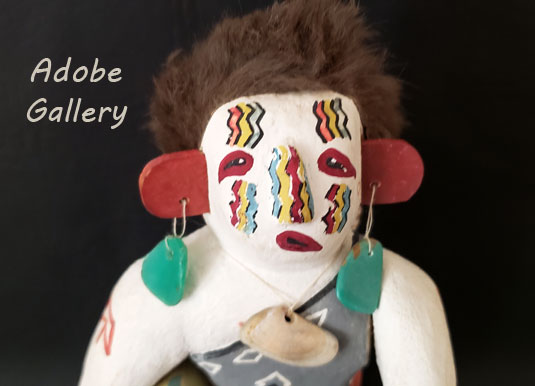Kachina Doll Hopi Pueblo Heheya Katsina [SOLD]
+ Add to my watchlist Forward to Friend
- Category: Traditional
- Origin: Hopi Pueblo, Hopituh Shi-nu-mu
- Medium: wood, paint, shell, fur, plastic, yarn
- Size: 7-½” tall
- Item # C4446H SOLD
This carving is an excellent representation of one of the varieties of Heheya, as they differ at each of the mesas. It is an all-wood carving and painted with paints that represent those dolls from the mid-twentieth century. His face carries the colorful markings and the deformed mouth of this katsina. He has a basket on his back with watermelon and four colors of corn, and another watermelon tucked under his arm. He is adorned with fake turquoise earrings and a shell necklace. His hair is fake fur. He is not signed with the name of the artist.
According to Barton Wright, Heheya Aumutaka means "like Heheya" and this version of Heheya appears only in Third Mesa villages. Other versions appear in First Mesa and Second Mesa villages. The interesting thing about this Katsina is that he speaks the opposite of what he means. If he says something is "good," he means it is "bad." Formerly he accompanied the Soyoko when they appeared at Third Mesa but since the Soyoko no longer come, his role is shifting to that of a general Powamu Katsina.
This katsina is one of the sons of the Ogres. He is frequently a runner or a slave or servant for the Ogres. He has been known to threaten the children and to carry food to the kivas where it is stored until evening. Sometimes he will carry a rope to threaten the children or to lasso an unwary onlooker. He is considered an Ogre when he appears in this way. When he appears in the night dances, he behaves in a lewd or lecherous manner until one of the Ogre Manas (female) puts a stop to it.
When we were preparing to publish a book on Hopi Katsinam based on paintings by Neil David, Sr., a Hopi-Tewa of First Mesa, we showed the same paintings to Hopi at different villages to obtain their comments on the katsinas, as explanations differ from village to village.
An informant at the Village of Shungopavi on Second Mesa stated: “This is just a variation of the Heheya Kachina. On First Mesa he has a white face, at Second Mesa he has a black face, and at Third Mesa he has a yellow face. He does appear at Shungopavi. The marks on his arm show that he is lewd and will chase after girls.”
An informant at Old Oraibi on Third Mesa stated: “He is a side dancer for the Kuwan Heheya group of Kachinas. The following is a tale concerning the face of this Kachina—The Heheyas were in the village when the village was attacked by an enemy. The Heheya went into a nearby cave to escape and hide. The enemy saw them and started a fire in the cave and that is why the Kachina’s mouth is deformed and why he has no feathers. He will often use a chile ristra in the place of the feathers.”
At Kykotsmovi Village on Third Mesa, our informant added to the story above “that the fire made the regular color of the Heheya run, thereby leaving his face with the variety of colors as shown. This Kachina will act as the carrier of the metate and mano for the corn grinding maidens. At Third Mesa his arms are marked with female genitalia. It is frequently joked that the length of the line on the Kachina’s arm is as long as the impersonator’s penis.”
Condition: very good condition
Provenance: this Kachina Doll Hopi Pueblo Heheya Katsina is from the collection of a client from California
References:
- Wright, Barton. Kachinas a Hopi Artist’s Documentary, 1973
- Anthony, Alexander, and Brent Ricks. KACHINAS Spirit Beings of the Hopi
Relative Links: Hopi Pueblo, Katsina Dolls

- Category: Traditional
- Origin: Hopi Pueblo, Hopituh Shi-nu-mu
- Medium: wood, paint, shell, fur, plastic, yarn
- Size: 7-½” tall
- Item # C4446H SOLD



